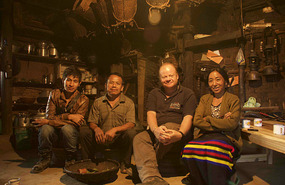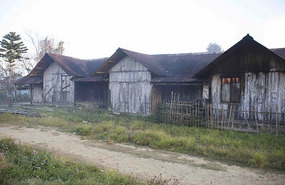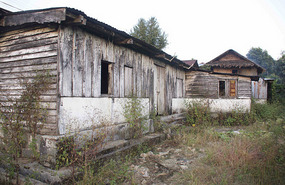Back in Mon, our problems with finding accommodation re-surfaced. I was not keen to stay in the Circuit Guesthouse again, so we spent our time at the Sumo Terminal trying to contact the Mon Lodge - who strangely were not answering their phones.
This appeared to be the only private option other than Helsa’s Cottage
. Helsa’s is run by a lady (again affectionally known as Auntie) and is considered by most to be the best accommodation in town. Unfortunately for the second time, it was full - so we were faced with the government run Circuit or the Paramount Guesthouse or the Mon Lodge.
I knew the Circuit guesthouse was dirty and short on customer service, and the Paramount was in the middle of the dusty area so I was keen on the Lodge. With no response to our phone calls, the only solution was to walk there with the bags. With no taxis around we wandered to Helsa’s and got directions to the Lodge. The dusty roads of Mon are hilly and in the morning heat it was quite taxing hauling the bags up and down the roads towards the Lodge. Ayoun was suffering from blisters so he returned home.
Eventually we came across the modern Mon Lodge with not a resident in sight
. The woman who met us was a little curt and unfriendly but did acknowledge that she had seen no customers in weeks. This admission should have started my alarm bells ringing, but she showed us into the building and up the stairs to two large rooms, one en-suite with hot water geysers, fixed showers and western toilets. I was not so keen on the price as it appeared high but she would not budge so I agreed.
On a few minutes reflection it seemed odd to charge the same for a room with ensuite bathroom as one with a shared toilet so I complained to the woman who reluctantly came to show me a second room, this time ensuite. The room this time had not been cleaned for ages, had someone’s washing hanging on the windows, litter strewn across the floor including bathroom disposables and was a little smelly, but Langa was positive saying once it was clean it would be OK. The woman said she would send up the cleaner.
A 15 year boy arrived with a duster dully arrived and then shut himself in Langa’s room
. I was starting to angry and when eventually we opened the door he was doing nothing, just staring out of the window. Seeing this bizarre behaviour I went to have a closer inspection of my room only to find animal excrement (mouse or rat - I was unsure which) in the bed, on the floor under the bed and all over the window sills.
After another complaint, the boy was marshalled into mine by the manageress (who was now also getting angry. Most strangely with us rather than her cleaners). The boy of course did nothing despite me asking him to do the bathroom. When he had finished, I then inspected my bathroom. The geyser was not working, there were so many pubic hairs over the basin and the taps you could have stuffed a pillow with them and the cleaning utensils were just discarded everywhere by the boy. I exploded and we packed up and left, with the manageress complaining about OUR behaviour after us.
Now it was getting dark and another up walk was the only alternative up to the Circuit Guesthouse
. This was another exhausting climb and on arrival we met the smiling manager (same man as the one we had met earlier) who informed me he was full. Faced with no taxis and no rooms Langa and I started to debate our options when two Indian businessmen and their Naga driver over heard our conversation. Within minutes all three suggested I use the spare bed in the driver’s twin room. How nice! Langa quickly sorted out room at Ayoun’s sisters and we were sorted.
That night I dined again at Ayoun’s house before returning back to the Circuit. The driver left the next morning at 5.30am with the businessman refusing to accept any money and at just after 7.00 I walked out back down to Ayoun's. The three of us enjoyed a leisurely breakfast in the warm sunshine before tramping down to the Sumo Terminal to catch our booked Sumo to Wakching, Ayoun’s home village.
Down there we bumped into Ben & Elodea who were trying to get Assam, but unaware there was a general strike. Luckily for them Langa managed to get two seats in a Sumo that was breaking the strike and they left for the station. As for us, our Sumo never arrived and in the end Ayoun had to contact his uncle and ask for a lift. As I was advised, I bought fresh Pork from the market for everyone who was helping me such as Ayoun’s sister, uncle and the Wakching Town Governor who was giving me some accommodation in the town.
The trip across the hills in Ayoun’s uncle’s little Suzuki involved transversing some more miserable roads (more akin to riverbeds than roads) but they the scenery was beautiful. 32 kilometres took 90 minutes, but arrive we did and straight into his uncle’s place. Here his wife had cooked an enormous pork dish for us and boy was this good with a rich chilli gravy and covered in lemon juice.
Soon we were walking through town to meet Ayoun’s lovely mother plus his brother and sister before going to see the governor and deputy governor. Everyone was friendly, desperate to have their photos taken with me and fascinated by my interest in the British Naga history of the area. Unfortunately the governor’s wife had also cooked another meal and all of a sudden I thought I would explode.
The deputy governor was also a gunsmith and a proper one at that, and we soon were invited into his work shop. There was not a hint of opium addiction here I am pleased to report. His gunsmith skills were impressive taking just a few hours to make a typical Naga machete type knife and just three days for a rifle. I declined an invitation to shoot one.
After this we climbed back up the narrow pathways to past the attractive family huts and houses to the top of the village where the deputy governor introduced me to a local historian who took me to the British Medical Outpost that was built in 1928 and also the dispensing centre constructed in the same year. This was interesting and whilst one family lived in the medical centre, the dispensing house was now unused and falling into disrepair. The local historian was only too pleased to tell me about the history of the buildings, adding that they wished to restore these building once they had raised the money.
After an interesting chat we venture off through the village again and the narrow steps to met a second man, Mr Youngya, who had researched the history of the village for the town’s centenary in 2013. His ten years of travelling around the area interviewing the elders resulted in a comprehensive history of the British in this Western Konyak region which he published in 2013 in the town’s centenary book. His research concentrated on oral histories related by village elders and old people. This was the first time his research has been published and has shone a light on a misunderstood and misrepresented era of history involving the British and the Konyak Nagas.
What his analysis of oral history shows is that the British were involved with the Konyaks before the outbreak of WW1. In fact first contact in Wakching appears to be sometime between 1897-99. The British were compelled to venture into Konyak territory to meet the locals to allay fears over disruptive Naga attacks on their search for coal and their established mining activities. They knew there was coal in the Wakching area as tribesman had ventured into their base at Tamlu to sell coal. They contacted the tribal leaders from the peoples living around the Wakching area and called a meeting at their base in Tamlu, on the fringes of Western Nagaland, bordering Sibsagar. At this meeting they reached an agreement with the peoples of Wakching that allowed the British unhindered access to their lands in exchange for education and medical facilities plus a guarantee of inter tribal peace.
In 1911, an advance party of British troops had attacked the village of Chinglong which had never been a party to any agreement. The British soldiers numbering around 50, suffered 3 casualties and were beaten back to the Konyak warriors. However in 1913, the village of Chinglang was eventually subdued and brought into the administrative area of Konyak. This enabled the building of medical and dispensary buildings at the current site of the two of Watching in 1913. This administrative area of Wakching was peaceful from this time onwards right up until after the British departure in 1947.
What was also intriguing to find out was the role of opium in this story. “Opium was always used by the Konyaks of this area,” remarked Mr Yongya. Contrary to what I had regularly been told the British army was not bringing opium to the Konyaks for the first time and facilitating their addiction, but Mr Yongya argued, they were actually rationing it to addicts who were known as “card holders” and they were withdrawing these ration cards in the event of an addict’s death. Consequently it appears that according to Mr Yongya’s research the British were actually trying to reduce the numbers of addicts whilst controlling the supply. This was something I had not heard of before and was obviously only confined to the administrative area such as Wakching. The village of Longwa in the east was an unadministered area and therefore opium use was far more prevalent and common, although the drug was not easy to find.
This conversation was fascinating and the three of us were huddled around the fire on Naga stools listening to Mr Yongya confidently and enthusiastically talk about his research. This clearly answered some of my questions as to why the Konyaks “liked” the British and had no intention of supporting then Japanese in WW2. As the British were instrumental in improving the education and health of the Konyaks, this explained in some way the loyalty of these people to the British. Mr Yongya was also at pains to explain that the people of the administrative areas were also pleased that the British had some success curtailing the tribes practice of headhunting. However this was not totally successful and he believed this headhunting practice was one of the reason why the British forces attacked the village of Chinglong.
I was given a copy of the Wakching Town Centennial Journal as a souvenir and we left Mr Yongya quite late. The next morning was again an early start, after we had said goodbye to Ayong’s family, we climbed to the top of the village to get a Sumo back to Mon. It was a beautiful journey in the morning sun alongside the rolling green Naga hills. The road (if thats the right descriptor) hugged the hills overlooking the valleys which were all covered in mist for the duration of the trip - memorable.
History, bad guesthouses, hills, Wakching
Friday, November 14, 2014
 Mon, Nagaland, India
Mon, Nagaland, India
Other Entries
-
67Robbery, Raw Fish, Cloudy and Drizzle
Aug 05101 days prior Lima, Peruphoto_camera4videocam 0comment 0
Lima, Peruphoto_camera4videocam 0comment 0 -
68Camille Schaeffer and Family RIP
Aug 1195 days prior Lima, Peruphoto_camera1videocam 0comment 0
Lima, Peruphoto_camera1videocam 0comment 0 -
69Rest, Lines, Vines and Sand
Aug 1294 days prior Ica, Peruphoto_camera4videocam 0comment 0
Ica, Peruphoto_camera4videocam 0comment 0 -
70Incas, Ruins, Trains, Parasites, Veganism
Aug 1987 days prior Cusco, Peruphoto_camera4videocam 0comment 2
Cusco, Peruphoto_camera4videocam 0comment 2 -
71Cloud Forest, Ruins, Birds, Animals, 50th
Aug 2482 days prior Manu National Park, Peruphoto_camera5videocam 0comment 0
Manu National Park, Peruphoto_camera5videocam 0comment 0 -
7250th part 2, Otters, Macaws, Jaguar, Tiramisu
Aug 3076 days prior Puerto Maldonado, Peruphoto_camera6videocam 0comment 0
Puerto Maldonado, Peruphoto_camera6videocam 0comment 0 -
73Finches, Volcanos, Tortoises & Darwin
Sep 0372 days prior Puerto Ayora, Ecuadorphoto_camera7videocam 0comment 0
Puerto Ayora, Ecuadorphoto_camera7videocam 0comment 0 -
74Sharks, Penguins, Sea Lions and Boobys
Sep 1065 days prior Puerto Villamil, Ecuadorphoto_camera6videocam 0comment 0
Puerto Villamil, Ecuadorphoto_camera6videocam 0comment 0 -
75Frigates, Poor Service, Iguanas, Diving Pelicans
Sep 1362 days prior Guayaquil, Ecuadorphoto_camera5videocam 0comment 0
Guayaquil, Ecuadorphoto_camera5videocam 0comment 0 -
76Car Crash, Chachas, Mules and Blood
Sep 1857 days prior Chachapoyas, Peruphoto_camera4videocam 0comment 0
Chachapoyas, Peruphoto_camera4videocam 0comment 0 -
77Kuelap, Mummies, Ruins, Hummingbirds
Sep 2550 days prior Leymebamba, Peruphoto_camera6videocam 0comment 0
Leymebamba, Peruphoto_camera6videocam 0comment 0 -
78Sarcophagi, Fountains of Blood, Horseback
Sep 2847 days prior Cuispes, Peruphoto_camera3videocam 0comment 0
Cuispes, Peruphoto_camera3videocam 0comment 0 -
79Waterfalls, Rain and Loud Peruvian Pop Music
Sep 2946 days prior Pedro Ruiz, Peruphoto_camera4videocam 0comment 0
Pedro Ruiz, Peruphoto_camera4videocam 0comment 0 -
80Hummingbirds, Orchids, Coffee and Stomach Bugs
Oct 0243 days prior Moyobamba, Peruphoto_camera5videocam 0comment 0
Moyobamba, Peruphoto_camera5videocam 0comment 0 -
81Battlefields, Zulus, 1879, Leaving South Africa
Oct 1827 days prior Dundee, South Africaphoto_camera4videocam 0comment 0
Dundee, South Africaphoto_camera4videocam 0comment 0 -
82Mr India, X Factor Naga style, Exotic Food
Nov 068 days prior Mokokchung, Indiaphoto_camera5videocam 0comment 0
Mokokchung, Indiaphoto_camera5videocam 0comment 0 -
83Burma, Headhunters, Opium & Dust
Nov 095 days prior Launghe, Myanmarphoto_camera4videocam 0comment 0
Launghe, Myanmarphoto_camera4videocam 0comment 0 -
84History, bad guesthouses, hills, Wakching
Nov 14 Mon, Indiaphoto_camera4videocam 0comment 0
Mon, Indiaphoto_camera4videocam 0comment 0 -
85Skulls, Fertility, Opium, Anghs, Warriors
Nov 173 days later Shengnya, Indiaphoto_camera5videocam 0comment 0
Shengnya, Indiaphoto_camera5videocam 0comment 0 -
86Elders, Changs, Culture, Families and Skulls
Nov 228 days later Tuensang, Indiaphoto_camera5videocam 0comment 0
Tuensang, Indiaphoto_camera5videocam 0comment 0 -
87Sangai Festival - Kang, Hockey/Wrestling, Polo etc
Nov 2814 days later Imphal, Indiaphoto_camera5videocam 0comment 0
Imphal, Indiaphoto_camera5videocam 0comment 0 -
88Hornbill Festival, Loin Looms & Naga Culture
Dec 1026 days later Kohima, Indiaphoto_camera10videocam 0comment 0
Kohima, Indiaphoto_camera10videocam 0comment 0 -
89Birds, Rubbish, Grasslands, Rubble, Tribes etc
Dec 1430 days later Nakhatrana , Indiaphoto_camera5videocam 0comment 0
Nakhatrana , Indiaphoto_camera5videocam 0comment 0 -
90Embroidery, Rogan, Block Printing, Tribes
Dec 1733 days later Bhuj, Indiaphoto_camera5videocam 0comment 0
Bhuj, Indiaphoto_camera5videocam 0comment 0 -
91Lions, Nitin, Bird Spotting, Sleeper Bus Part 1
Dec 2137 days later Gir, Indiaphoto_camera6videocam 0comment 0
Gir, Indiaphoto_camera6videocam 0comment 0 -
92Island Life, Portuguese Colony, Christmas
Dec 2541 days later Diu, Indiaphoto_camera4videocam 0comment 0
Diu, Indiaphoto_camera4videocam 0comment 0 -
93Restaurant Tombs, Mosques, Markets
Dec 2844 days later Ahmedabad, Indiaphoto_camera5videocam 0comment 0
Ahmedabad, Indiaphoto_camera5videocam 0comment 0 -
94Birds, NYE, Dhows, Feral Dogs, Shaves
Dec 3147 days later Mandvi, Indiaphoto_camera6videocam 0comment 0
Mandvi, Indiaphoto_camera6videocam 0comment 0 -
95Blue Moon, Salt Flats, Crafts
Jan 0249 days later Bhujodi, Indiaphoto_camera5videocam 0comment 0
Bhujodi, Indiaphoto_camera5videocam 0comment 0 -
96Calico Musuem, Festival Prep, Street Life
Jan 0653 days later Ahmedabad, Indiaphoto_camera5videocam 0comment 0
Ahmedabad, Indiaphoto_camera5videocam 0comment 0 -
97Leopards, Shepherds, Turbans and Aristocrats
Jan 1158 days later Bhenswara, Indiaphoto_camera5videocam 0comment 0
Bhenswara, Indiaphoto_camera5videocam 0comment 0 -
98Birds, Fog, Bad Internet, Old Friends
Jan 1461 days later Jodhpur, Indiaphoto_camera7videocam 0comment 0
Jodhpur, Indiaphoto_camera7videocam 0comment 0 -
99Tigers Tigers Tigers Tigers and oh Tigers
Jan 1764 days later Sawai Madhopur, Indiaphoto_camera6videocam 0comment 0
Sawai Madhopur, Indiaphoto_camera6videocam 0comment 0 -
100Trains, Rodents, Rip offs, Delhi and Gentle
Jan 2572 days later Delhi, Indiaphoto_camera3videocam 0comment 0
Delhi, Indiaphoto_camera3videocam 0comment 0 -
101Sand, Masks, Forest Man, Monks & Bamboo
Feb 0280 days later Majuli, Indiaphoto_camera8videocam 0comment 0
Majuli, Indiaphoto_camera8videocam 0comment 0 -
102Julius, Gibbons, Park Fees, Tea & Gymkhana
Feb 0583 days later Jorhat, Indiaphoto_camera5videocam 0comment 0
Jorhat, Indiaphoto_camera5videocam 0comment 0

 Mon, Nagaland, India
Mon, Nagaland, India








2025-05-22